Altered ATP7A expression and other compensatory responses in a murine model of Menkes disease
- PMID: 17588765
- PMCID: PMC2040029
- DOI: 10.1016/j.nbd.2007.05.004
Altered ATP7A expression and other compensatory responses in a murine model of Menkes disease
Abstract
Mutations in the copper-transporter ATP7A lead to severe neurodegeneration in the mottled brindled hemizygous male (MoBr/y) mouse and human patients with Menkes disease. Our earlier studies demonstrated cell-type- and -stage-specific changes in ATP7A protein expression during postnatal neurodevelopment. Here we examined copper and cuproenzyme levels in MoBr/y mice to search for compensatory responses. While all MoBr/y neocortical subcellular fractions had decreased copper levels, the greatest decrease (8-fold) was observed in cytosol. Immunostaining for ATP7A revealed decreased levels in MoBr/y hippocampal pyramidal and cerebellar Purkinje neurons. In contrast, an upregulation of ATP7A protein occurred in MoBr/y endothelial cells, perhaps to compensate for a lack of copper in the neuropil. MoBr/y astrocytes and microglia increased their physical association with the blood-brain barrier. No alterations in ATP7A levels were observed in ependymal cells, arguing for specificity in the alteration observed at the blood-brain barrier. The decreased expression of ATP7A protein in MoBr/y Purkinje cells was associated with impaired synaptogenesis and dramatic cytoskeletal dysfunction. Immunoblotting failed to reveal any compensatory increase in levels of ATP7B. While total levels of several cuproenzymes (peptide-amidating monooxygenase, SOD1, and SOD3) were unaltered in the MoBr/y brain, levels of amidated cholecystokinin (CCK8) and amidated pituitary adenylate cyclase-activating polypeptide (PACAP38) were reduced in a tissue-specific fashion. The compensatory changes observed in the neurovascular unit provide insight into the success of copper injections within a defined neurodevelopmental period.
Figures
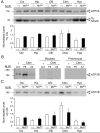
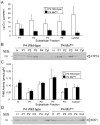
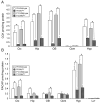
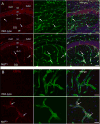
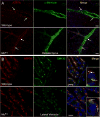
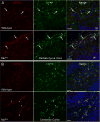
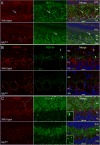
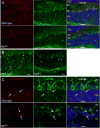
Similar articles
-
Developmental changes in the expression of ATP7A during a critical period in postnatal neurodevelopment.Neuroscience. 2006;139(3):947-64. doi: 10.1016/j.neuroscience.2006.01.044. Epub 2006 Mar 23. Neuroscience. 2006. PMID: 16549268
-
Small amounts of functional ATP7A protein permit mild phenotype.J Trace Elem Med Biol. 2015;31:173-7. doi: 10.1016/j.jtemb.2014.07.022. Epub 2014 Aug 8. J Trace Elem Med Biol. 2015. PMID: 25172213 Review.
-
Mutation in the CPC motif-containing 6th transmembrane domain affects intracellular localization, trafficking and copper transport efficiency of ATP7A protein in mosaic mutant mice--an animal model of Menkes disease.Metallomics. 2012 Feb;4(2):197-204. doi: 10.1039/c1mt00134e. Epub 2011 Nov 16. Metallomics. 2012. PMID: 22089129
-
Autonomous requirements of the Menkes disease protein in the nervous system.Am J Physiol Cell Physiol. 2015 Nov 15;309(10):C660-8. doi: 10.1152/ajpcell.00130.2015. Epub 2015 Aug 12. Am J Physiol Cell Physiol. 2015. PMID: 26269458 Free PMC article.
-
ATP7A-related copper transport diseases-emerging concepts and future trends.Nat Rev Neurol. 2011 Jan;7(1):15-29. doi: 10.1038/nrneurol.2010.180. Nat Rev Neurol. 2011. PMID: 21221114 Free PMC article. Review.
Cited by
-
Neuronal copper homeostasis susceptibility by genetic defects in dysbindin, a schizophrenia susceptibility factor.Hum Mol Genet. 2015 Oct 1;24(19):5512-23. doi: 10.1093/hmg/ddv282. Epub 2015 Jul 21. Hum Mol Genet. 2015. PMID: 26199316 Free PMC article.
-
Elevated adult neurogenesis in brain subventricular zone following in vivo manganese exposure: roles of copper and DMT1.Toxicol Sci. 2015 Feb;143(2):482-98. doi: 10.1093/toxsci/kfu249. Epub 2015 Jan 8. Toxicol Sci. 2015. PMID: 25575534 Free PMC article.
-
Copper metabolism of astrocytes.Front Aging Neurosci. 2013 Mar 14;5:9. doi: 10.3389/fnagi.2013.00009. eCollection 2013. Front Aging Neurosci. 2013. PMID: 23503037 Free PMC article.
-
Elesclomol alleviates Menkes pathology and mortality by escorting Cu to cuproenzymes in mice.Science. 2020 May 8;368(6491):620-625. doi: 10.1126/science.aaz8899. Science. 2020. PMID: 32381719 Free PMC article.
-
Aberrant Adult Neurogenesis in the Subventricular Zone-Rostral Migratory Stream-Olfactory Bulb System Following Subchronic Manganese Exposure.Toxicol Sci. 2016 Apr;150(2):347-68. doi: 10.1093/toxsci/kfw007. Epub 2016 Jan 21. Toxicol Sci. 2016. PMID: 26794142 Free PMC article.
References
-
- Barnes N, Tsivkovskii R, Tsivkovskaia N, Lutsenko S. The copper-transporting ATPases, menkes and wilson disease proteins, have distinct roles in adult and developing cerebellum. J Biol Chem. 2005;280:9640–9645. - PubMed
-
- Berghs S, Aggujaro D, Dirkx R, Jr, Maksimova E, Stabach P, Hermel JM, Zhang JP, Philbrick W, Slepnev V, Ort T, Solimena M. betaIV spectrin, a new spectrin localized at axon initial segments and nodes of ranvier in the central and peripheral nervous system. J Cell Biol. 2000;151:985–1002. - PMC - PubMed
-
- Bertrand E, Lewandowska E, Szpak GM, Hoogenraad T, Blaauwgers HG, Czlonkowska A, Dymecki J. Neuropathological analysis of pathological forms of astroglia in Wilson’s disease. Folia Neuropathol. 2001;39:73–79. - PubMed
-
- Brown DR. Metallic prions. Biochem Soc Symp. 2004:193–202. - PubMed
-
- Bush AI. The metallobiology of Alzheimer’s disease. Trends Neurosci. 2003;26:207–214. - PubMed
Publication types
MeSH terms
Substances
Grants and funding
LinkOut - more resources
Full Text Sources
Molecular Biology Databases
Miscellaneous

